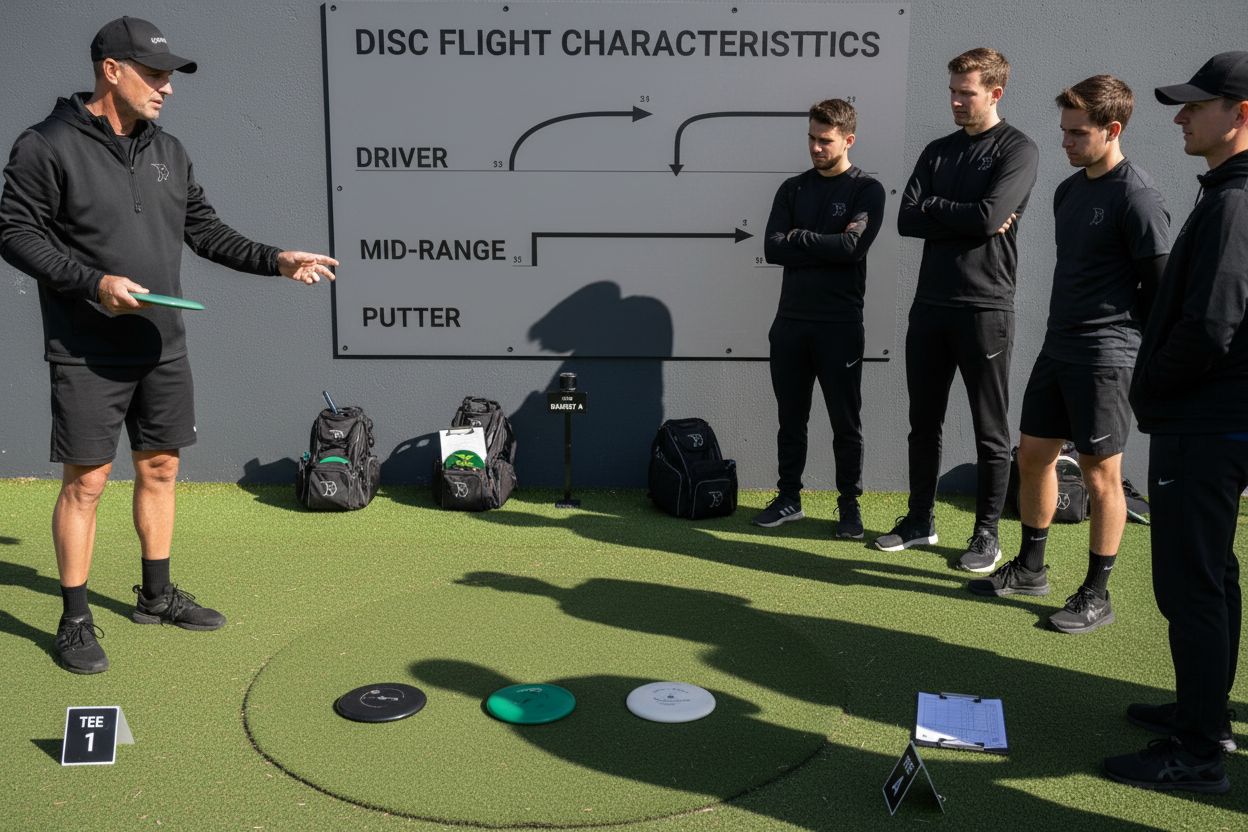
Disc Golf Terms: Everything You Need to Know
Did you know a hole-in-one, or ace, in disc golf occurs in less than one out of every thousand throws? Scoring terms and disc selection shape every round, setting both new and experienced players apart. Whether you’re perfecting your throws or tracking your progress, learning these key rules and definitions can make every hole more rewarding and every challenge on the course easier to understand.
Key Takeaways
| Point | Details |
|---|---|
| Scoring Terminology | Aces, birdies, eagles, and more are critical scoring terms that signify levels of achievement relative to par in disc golf. Understanding these terms enhances player performance tracking. |
| Disc Types and Stability | Players should choose from drivers, mid-range discs, and putters based on flight stability, as these greatly influence their throws and overall gameplay. |
| Throwing Techniques | Mastering backhand and forehand throws, along with release angles like hyzer and anhyzer, is essential for effective disc control and strategic play. |
| Course Markers | Knowledge of course markers such as mandatories and out-of-bounds zones is vital for navigating and strategizing on disc golf courses. |
Table of Contents
- What “Ace” Through “Par” Mean
- Types of Discs and Flight Stability
- Throwing Styles and Angle Terms
- Course Markers Like Mando, Ob, Drop Zone
What “Ace” through “Par” Mean
In disc golf, scoring terms tell a fascinating story of skill and precision. Ace represents the ultimate achievement: sinking your disc directly into the basket from the tee on your first throw. According to DiscGolfNow, aces most commonly occur on par-3 holes and are considered rare, celebratory moments in the sport.
The scoring progression follows a similar pattern to traditional golf, with players tracking their performance relative to the expected number of throws per hole. Par represents the standard number of throws a skilled player should require to complete a specific hole. From there, players can achieve various scoring levels:
- Birdie: One throw under par
- Eagle: Two throws under par
- Albatross/Double-eagle: Three throws under par
- Condor: Four throws under par
These standardized scoring terms are globally recognized and governed by Professional Disc Golf Association (PDGA) rules. While an ace might sound simple, it requires tremendous skill, precise throwing technique, and a bit of luck. Players often commemorate their first ace with special traditions, like signing the disc or buying drinks for fellow players at the course.
Here’s a summary of disc golf scoring terms and meanings:
| Term | Throws Relative to Par | Description |
|---|---|---|
| Ace | First throw (from tee) | Hole-in-one |
| Eagle | Two under par | Exceptional performance |
| Birdie | One under par | Skillful, slightly better than par |
| Par | Even | Standard for a skilled player |
| Albatross/Double-eagle | Three under par | Extremely rare achievement |
| Condor | Four under par | Virtually unprecedented |
Types of Discs and Flight Stability
Disc golf requires a strategic approach to equipment, with different types of discs designed for specific purposes and flight characteristics. According to Wikipedia, disc golf discs are broadly categorized into three essential types: drivers, mid-range discs, and putters. Each type serves a unique role in a player’s arsenal, helping them navigate the complex landscape of the disc golf course.
Drivers are built for maximum distance and power, typically featuring sharper edges and more aerodynamic designs. Mid-range discs offer a balance between distance and control, making them versatile tools for various shot types. Putters, with their blunt edges and slower flight characteristics, are precision instruments used for short-distance accuracy, especially when approaching or completing a hole. Read more about disc flight characteristics in our detailed guide on disc stability.
Understanding flight stability is crucial for selecting the right disc. Discs can be classified as understable, stable, or overstable, which describes how they behave during flight. An understable disc tends to turn right for right-handed backhand throws, a stable disc flies relatively straight, and an overstable disc will hook sharply left. This nuanced understanding helps players choose discs that complement their throwing style and the specific demands of each hole.

Throwing Styles and Angle Terms
Disc golf is as much an art of technique as it is of equipment, with players developing unique throwing styles that dramatically impact their game. According to Wikipedia, two primary throwing techniques dominate the sport: backhand and forehand (or sidearm). The backhand throw mimics a traditional frisbee toss, while the forehand involves releasing the disc from the side of the body, each offering distinct advantages in different course scenarios.
The magic of disc golf lies in understanding release angles, which fundamentally change a disc’s flight path. Hyzer and anhyzer are critical terms that describe how a disc is released relative to the player’s body. As explained by the Disc Golf Pro Tour, a hyzer release tilts the disc’s outside edge downward, causing it to fade left for right-handed throwers, while an anhyzer release tilts the outside edge upward, creating a right-turning flight path.
Advanced players expand their repertoire with complex throwing techniques like flex shots and S-curve shots. A flex shot involves throwing an overstable disc on an anhyzer angle, allowing it to straighten out mid-flight, while an S-curve shot uses an understable disc thrown on a slight hyzer angle that turns and then fades back, creating a serpentine trajectory. Learn more about advanced disc flight techniques in our comprehensive disc stability guide. These nuanced techniques transform disc golf from a simple throwing game into a strategic art form that rewards creativity and precise technique.
Course Markers like Mando, OB, Drop Zone
Disc golf courses are complex strategic landscapes marked with various directional and penalty indicators that challenge players beyond simple throwing skills. Mandatories (or Mandos) are critical course markers that require players to navigate their disc through specific paths, often mandating that the disc pass on a particular side of an obstacle or marker. According to Wikipedia, these markers ensure players follow a predetermined route and add an extra layer of complexity to the game.
Another crucial course element is the Out-of-Bounds (OB) zone, which imposes penalties when a disc comes to rest in a designated area. UDisc explains that PDGA rules specify precise consequences for OB violations. When a disc lands in an OB zone, players typically must take a penalty stroke and place their next throw in a specified drop zone – a predetermined area where play resumes after a rule violation. Learn more about course rules and mandatories in our detailed guide.
Interestingly, course designers use these markers strategically to increase difficulty, protect property boundaries, ensure player safety, and create unique throwing challenges. Mando rules actually take precedence over OB rules in terms of penalty assessment and lie placement, making them a critical component of competitive disc golf strategy. Understanding these markers isn’t just about following rules – it’s about mastering the intricate navigation of each unique course.
![]()
Ready to Master Every Disc Golf Term on the Course?
Struggling to decode disc golf lingo or unsure which disc matches your hyzer or anhyzer throw? You are not alone. Many players find themselves guessing when it comes to terms like ace, stability, or mando. Without the right gear and guidance, every course can feel like uncharted territory. Want to turn all that knowledge into better throws and lower scores?

Now is the perfect time to upgrade your disc golf experience. Head to our main shop at GolfDiscs.com and discover discs designed for every throwing style and skill level. Dive deeper into our guide on disc stability or sharpen your strategic edge by understanding what is a mando. Explore our handpicked selection and bring your new disc golf vocabulary to life on your next round. Visit GolfDiscs.com today and experience the advantage true knowledge brings.
Frequently Asked Questions
What does ‘Ace’ mean in disc golf?
An ‘Ace’ in disc golf refers to the achievement of getting the disc into the basket on the first throw from the tee, often celebrated among players.
How is scoring determined in disc golf?
Scoring in disc golf is based on the number of throws taken to complete each hole, with terms such as ‘Par’, ‘Birdie’, and ‘Eagle’ indicating performance relative to the expected number of throws.
What are the different types of discs used in disc golf?
Disc golf discs are categorized into three main types: drivers, mid-range discs, and putters, each serving a specific role in terms of distance, control, and precision.
What is a ‘Mando’ in disc golf?
A ‘Mando’ (mandatory) is a course marker that requires players to throw their disc on a specific side of an obstacle. Following these rules adds complexity and strategic planning to the game.
